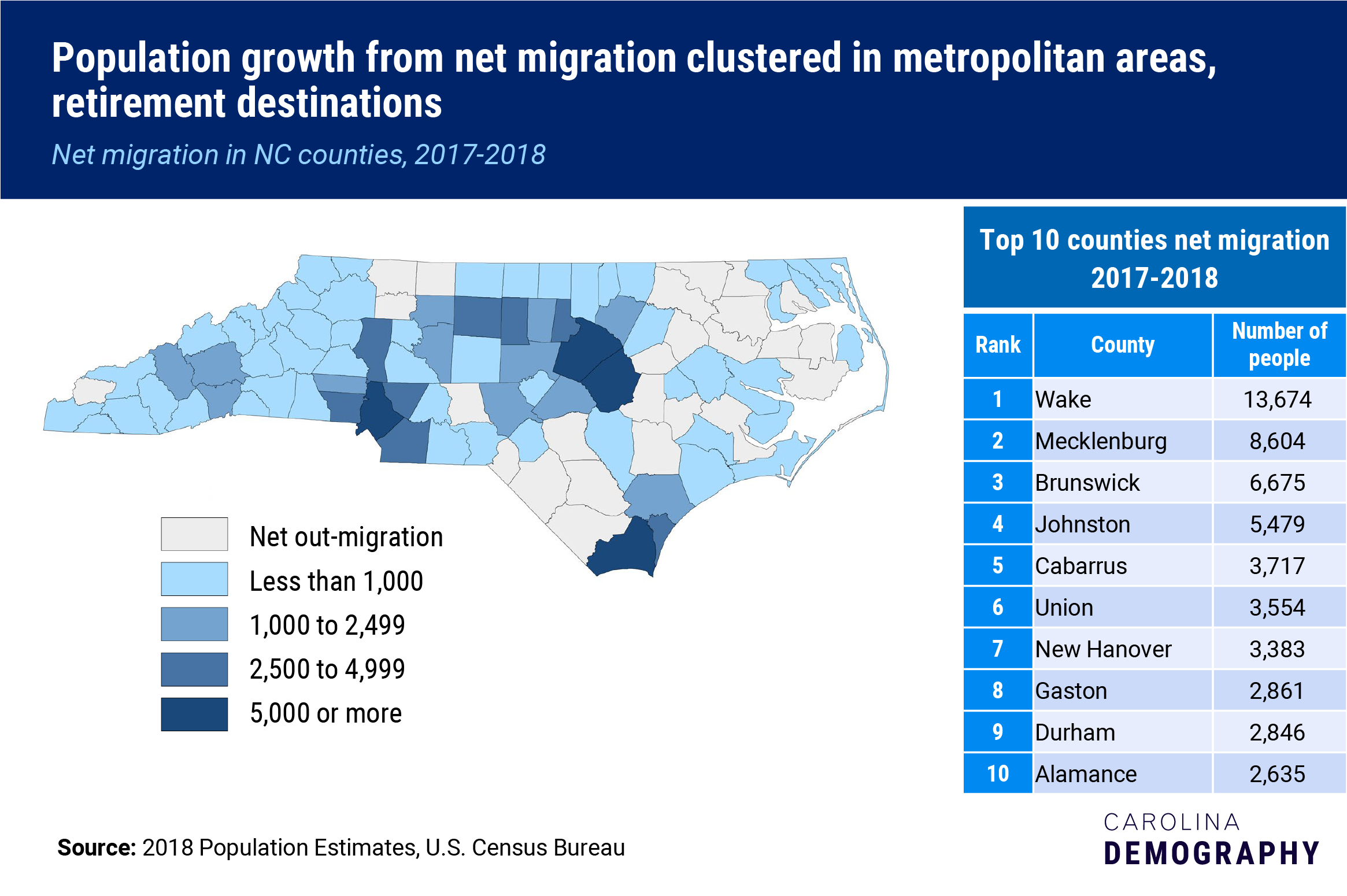These NC counties are experiencing the largest population gains from net migration

This is the second post in a three-post series looking at in-migration and out-migration in North Carolina. Read the first post in the series, “NC is rapidly growing. Where are our new residents moving from?“
Between 2017 and 2018, North Carolina grew by nearly 87,000 new residents from net in-migration from other states and countries. But that growth was concentrated in several areas within the state. Today, we’re looking at which NC counties have seen the largest population gains from net migration and what they have in common.
When we look at the top 10 counties for net migration gains between 2017 and 2018, there are three major types of counties on the list: urban cores, suburbs, and retirement destinations.

Urban Cores
Wake (home to Raleigh) grew more from net migration in 2017 than any other NC county. Wake added an estimated 13,700 new residents from net migration, more than 5,000 more than Mecklenburg (home to Charlotte) which came in second place with 8,600 net migrants. The counties home to Wilmington (New Hanover) and Durham (Durham) were also among the top 10 counties for gains from net migration.
Suburbs
Fast-growth in our two largest urban areas—Raleigh and Charlotte—is also spilling over into neighboring suburbs. Johnston (5.5K net migrants) outside of Raleigh and Cabarrus (3.7K), Union (3.6K), and Gaston (2.9K) counties outside of Charlotte are among the counties with the largest gains from net migration. Alamance County, centered between the metro regions of the Piedmont Triad (Greensboro-Winston-Salem-High Point) and the Research Triangle (Raleigh-Durham-Chapel Hill) had the 10th largest gains from net migration in 2017 (2.6K).
Retirement Destinations
Brunswick County (6.6K) had the third largest population gains from net migration in 2017 of any NC county. While Brunswick is technically part of the Myrtle Beach metropolitan area—and borders on New Hanover County (Wilmington)—most of its growth is from its appeal as a retirement destination, not from suburban spillover. Other retirement destinations, including most western NC counties and Moore County (home to Pinehurst and Southern Pines), also saw growth from net migration, though not to the same extent as Brunswick.
While many NC counties grew from net migration between 2017 and 2018, one in four counties lost population to net out-migration, meaning more people moved away than moved in. These counties were predominantly rural counties in northeastern North Carolina and the Sandhills, as well as a cluster of counties in the northwest and Graham County in the west.
Data Source: 2018 Population Estimates, U.S. Census Bureau.
Correction: In a previous version of this blog post, we listed Guilford County as among the fastest growing counties in terms of net migration. Guilford is ranked #11 in the state. We apologize for the error.
Need help understanding population change and its impacts on your community or business? Carolina Demography offers demographic research tailored to your needs.
Contact us today for a free initial consultation.
Contact UsCategories: Migration, NC in Focus

The Center for Women’s Health Research (CWHR) at the University of North Carolina School of Medicine released the 12th edition of our North Carolina Women’s Health Report Card on May 9, 2022. This document is a progress report on the…

Dr. Krista Perreira is a health economist who studies disparities in health, education, and economic well-being. In collaboration with the Urban Institute, she recently co-led a study funded by the Kate B. Reynolds Foundation to study barriers to access to…

Our material helped the NC Local News Lab Fund better understand and then prioritize their funding to better serve existing and future grant recipients in North Carolina. The North Carolina Local News Lab Fund was established in 2017 to strengthen…
Your support is critical to our mission of measuring, understanding, and predicting population change and its impact. Donate to Carolina Demography today.